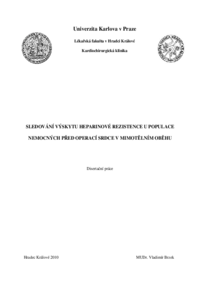Sledovánívýskytu heparinové resistence u populace nemocných před operací srdce v mimotělním oběhu
The incidence of heparin resistance in patients operated with the use of extracorporeal circulation
dizertační práce (OBHÁJENO)

Zobrazit/
Trvalý odkaz
http://hdl.handle.net/20.500.11956/23955Identifikátory
SIS: 91502
Kolekce
- Kvalifikační práce [1142]
Autor
Vedoucí práce
Oponent práce
Tošovský, Jan
Gwoździewicz, Marek
Fakulta / součást
Lékařská fakulta v Hradci Králové
Obor
-
Katedra / ústav / klinika
Kardiochirurgická klinika
Datum obhajoby
23. 6. 2010
Nakladatel
Univerzita Karlova, Lékařská fakulta v Hradci KrálovéJazyk
Čeština
Známka
Prospěl/a
Souhrn Přibližně u 20% populace se vyskytuje heparinová rezistence. V tom případě po podání běžné dávky heparinu, která je 2-3mg/kg nedojde k dostatečnému prodloužení ACT. Cíl: Stanovit skutečný výskyt heparinové rezistence u pacientů před kardiochirurgickou operací. Zjistit, zda je závislost mezi předoperační léčbou heparinem a výskytem heparinové rezistence. Dále zjistit, zda je závislost mezi počtem trombocytů, koncentrací antitrombinu, věkem pacientů a heparinovou rezistencí. Soubor pacientů a metodika: Během tří let jsme postupně zahrnuli do prospektivní studie celkem 624 pacientů před operací v mimotělním oběhu. U pacientů jsme sledovali hodnoty ACT (activated clotting time) před operací a během operace. U všech nemocných jsme sledovali čtyři faktory, které jsou v literatuře považovány za možné příčiny výskytu heparinové rezistence: věk ≥ 65 let, počet trombocytů předoperačně ≥ 300 × 109/l, předoperační podávání různých druhů heparinů, koncentrace antitrombinu ≤ 60 % a kombinace všech faktorů. Pokud dávka heparinu ≥ 5 mg/kg nevyvolala antikoagulační odpověď ≥ 480 s podle ACT, pak jsme pacienty zařadili do skupiny heparin-rezistentních. K vyhodnocení našich výsledků byl použit test shody relativní četnosti a χ2 test nezávislosti. Výsledky: V našem souboru se heparinová rezistence vyskytla u 203 z 624...
Heparin resistance occurs in about 20% of population. In that case, after application of a usual dose of heparin (2-3 mg/kg) ACT will not be sufficiently extended. Aim: To determine the real incidence of heparin resistance in patients scheduled for a cardiac surgical procedure. To determine whether there is an association between preoperative treatment with heparin and the incidence of heparin resistance. Also, to establish whether there is an association between platelet count, patients' age, and heparin resistance. Patients and methods: A total of 624 patients scheduled for on-pump surgery were included into a prospective study over a period of three years. Preoperative and intraoperative activated clotting time (ACT) values were recorded. Additionally, four factors referred to in the relevant literature as potential causes of developing heparin resistance were monitored in all patients: age 65 years, preoperative platelet count ≥ 300 × 109/l, preoperative administration of various types of heparin, antithrombin concentration ≤ 60%, and a combination of all. Patients were considered heparin-resistant if a heparin dose ≥ 5 mg/kg had not produced an anticoagulation response with ACT ≥ 480 s. Our data were evaluated using the test of agreement of relative frequency and the χ2 test. Results: In our...
